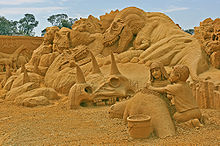uc
"Sandcastle" redirects here. For other uses, see Sandcastle (disambiguation).
Sand art is the practice of modelling sand into an artistic form, such as a sand brushing, sand sculpture, sandpainting, or sand bottles. A sand castleis a type of sand sculpture resembling a miniature building, often a castle.
The two basic building ingredients, sand and water, are available in abundance on a sandy beach, so most sand play takes place there, or in a sandpit. Tidal beaches generally have sand that limits height and structure because of the shape of the sand grains. Good sand sculpture sand is somewhat dirty, havingsilt and clay that helps lock the irregular shaped sand grains together.
Sand castles are typically made by children, simply for the fun of it, but there are also sand sculpture contests for adults that involve large, complex constructions.
Ukrainian talent contest winner, Kseniya Simonova, gained worldwide fame and became an online phenomenon with her sand painting which depicted World War II and how her family had been separated by the war.
Construction
Sand grains will not stick together unless the sand is reasonably fine. While dry sand is loose, wet sand is adherent if the proper amounts of sand and water are used in the mixture. The reason for this is that water forms little ‘bridges’ between the grains of sand when it is damp due to the forces of surface tension. However if too much water is added the water fills the spaces between the grains, breaking down the bridges and thus lowering the surface tension, resulting in the sand being able to flow more easily and the structure collapsing. According to the BBC TV programme Coast, the ideal ratio is eight parts dry sand to one part water, (though this may depend on the type of sand).
When the sand dries out or gets wet, the shape of a structure may change and "landslides" are common. Furthermore, the mixture of fine (mostly sharper) and coarse sand granules is very important to achieve good "sand construction" results. Fine granules which have been rounded by the natural influences of seas, rivers or fluvials, in turn negatively influence the bonding between the individual granules as they more easily slide past each other. Research is thus necessary to find the most suitable sand to achieve an optimal, landslide-free construction.
Shovels and buckets are the main construction tool used in creating sand castles and sand sculptures, although some people use only their hands. Water from the sea to mix with the sand can be brought to the building site with a bucket or other container. Sometimes other materials, such as pieces of wood, are added to reinforce structures.
Sand sculpting as an art form has become very popular in recent years especially in coastal beach areas. Hundreds of annual competitions are held all over the world. Techniques can be quite sophisticated, and record-breaking achievements have been noted in the Guinness World Records. Sometimes contests are staged as advertising or promotional events.
Some sandcastle artists are purists, using no artificial materials, formwork, coloring, adhesive or heavy machinery. One such purist is G. Augustine Lynas, who has been building public sand sculptures for over 50 years. However, in sand sculpting competitions, the rules often require that the finished sculpture be sprayed with a stabilizing coating that preserves it and allows the work to be properly judged and enjoyed by spectators. Coated sculptures can last for months.
PHOTOS




 6:42 AM
6:42 AM
 primitive
primitive











































 Posted in:
Posted in: 






0 comments:
Mag-post ng isang Komento